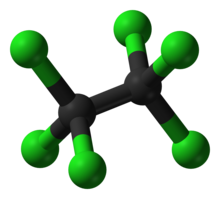Hexachloroethane

| |

| |
| Names | |
|---|---|
| IUPAC name
Hexachloroethane
| |
| Other names
Carbon hexachloride, Ethane hexachloride, Perchloroethane
| |
| Identifiers | |
3D model (JSmol)
|
|
| ChEBI | |
| ChEMBL | |
| ChemSpider | |
| ECHA InfoCard | 100.000.606 |
| EC Number |
|
| KEGG | |
PubChem CID
|
|
| UNII | |
CompTox Dashboard (EPA)
|
|
| |
| |
| Properties | |
| C2Cl6 | |
| Molar mass | 236.74 g/mol |
| Appearance | colorless crystals[1] |
| Odor | camphor-like[1] |
| Density | 2.091 g/mL at 25 °C |
| Melting point | 183 to 185 °C (361 to 365 °F; 456 to 458 K) sublimes |
| 0.005% (22.2 °C)[1] | |
| Vapor pressure | 0.2 mmHg (20 °C)[1] |
| -112.7·10−6 cm3/mol | |
| Hazards | |
| Occupational safety and health (OHS/OSH): | |
Main hazards
|
Probable carcinogen, dangerous CNS depression |
| NFPA 704 (fire diamond) | |
| Flash point | noncombustible[1] |
| Lethal dose or concentration (LD, LC): | |
LD50 (median dose)
|
4460 mg/kg (rat, oral) 4970 mg/kg (guinea pig, oral) |
| NIOSH (US health exposure limits): | |
PEL (Permissible)
|
TWA 1 ppm (10 mg/m3) [skin][1] |
REL (Recommended)
|
Ca TWA 1 ppm (10 mg/m3) [skin][1] |
IDLH (Immediate danger)
|
Ca [300 ppm][1] |
Except where otherwise noted, data are given for materials in their standard state (at 25 °C [77 °F], 100 kPa).
| |
Hexachloroethane, also known as perchloroethane (PCA), C2Cl6, is a white crystalline solid at room temperature with a camphor-like odor.[3] It has been used by the military in smoke compositions, such as base-eject smoke munitions (smoke grenades).
Manufacture
Hexachloroethane is a byproduct of many industrial chlorination processes.[3] It is currently being manufactured directly in India.[4] The overall reaction is shown below. This reaction occurs stepwise.
- C2H6 + 6 Cl2 → C2Cl6 + 6 HCl
Applications
Hexachloroethane has been used in the formulation of extreme pressure lubricants. It has also been used as a chain transfer agent in the emulsion polymerization of propylene tetrafluoroethylene copolymer. Hexachloroethane has been used as an anthelmintic in veterinary medicine, a rubber accelerator, a component of fungicidal and insecticidal formulations as well as a moth repellant and a plasticizer for cellulose esters.[3]
Smoke grenades, called hexachloroethane (HCE) smoke or HC smoke, utilize a mixture containing roughly equal parts of HCE and zinc oxide and approximately 6% granular aluminium. These smokes are toxic, which is attributed to the production of zinc chloride (ZnCl2).[5]
Hexachloroethane has been used in the manufacture of degassing pellets to remove hydrogen gas bubbles from molten aluminum in aluminum foundries. This use, as well as similar uses in magnesium, is being phased out in the European Union. It was phased out as early as 1999 in the United States.[4]
Toxicity
Hexachlorethane is not particularly toxic when taken orally,[6] but is considered to be quite toxic by skin adsorption. The primary effect is depression of the central nervous system.[3] The IDLH is given as 300 ppm and the OSHA PEL is 1 ppm (skin).[6] It is reasonably anticipated to be a carcinogen.[4]
References
- ^ a b c d e f g h NIOSH Pocket Guide to Chemical Hazards. "#0316". National Institute for Occupational Safety and Health (NIOSH).
- ^ "Hexachloroethane". Immediately Dangerous to Life or Health Concentrations (IDLH). National Institute for Occupational Safety and Health (NIOSH).
- ^ a b c d Snedecor, Gayle (1999). "Hexachloroethane". In Kroschwitz, Jacqueline I. (ed.). Kirk-Othmer Concise Encylclopedia of Chemical Technology (4th ed.). New York: John Wiley & Sons, Inc. p. 428. ISBN 978-0471419617.
- ^ a b c "Report on Carcinogens, Twelfth Edition, Hexachloroethane" (PDF). NIH. 2011. Retrieved 2012-10-04.
- ^ "Appendix E: Smoke And Masking Agents" (PDF). Australian Department of Veteran Affairs. December 2003. p. E-3. Archived from the original (PDF) on 2014-02-13. Retrieved 2012-10-04.
{{cite web}}: Unknown parameter|deadurl=ignored (|url-status=suggested) (help) - ^ a b "Documentation for Immediately Dangerous To Life or Health Concentrations (IDLHs) Hexachloroethane". NIOSH. May 1994. Retrieved 2012-10-04.

